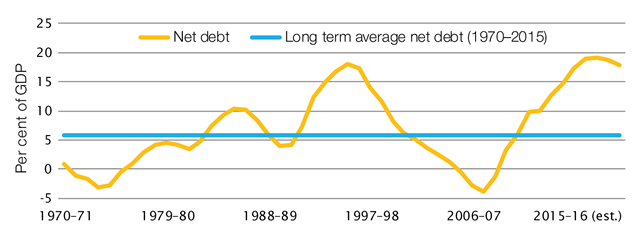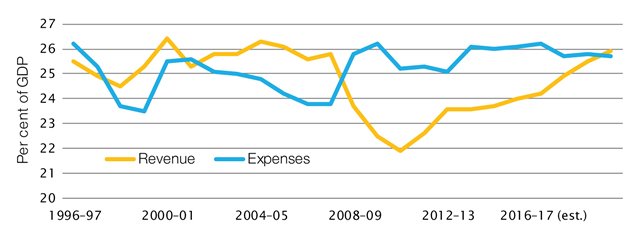Alicia Hall,
Statistics and Mapping
Key Issue
The ratings agency Standard and Poors recently revised its sovereign rating outlook on Australia from stable to negative, largely relating to concerns about the government sector’s ongoing fiscal position. This brief discusses the Australian Government’s current and historical debt levels, and revenues and expenses.
The Australian Government’s ‘net debt’ is at a reasonably
high level in a historical context (see Figure 1). Although net debt levels
are still low
by international standards, this issue is nonetheless considered a concern
by some commentators due to Australia’s
high level of overall net foreign debt (that is, both private and public
net foreign debt).
Australian Government debt is often reported as a relative indicator
to allow comparison across years. For example, debt can be expressed as a proportion
of Gross Domestic Product (GDP). In the 2016–17
Budget, the Government indicated that net debt in Australia has risen from a
low of -3.8 per cent of GDP in 2007–08 to an estimated 18.9 per cent of GDP in
2016–17. Based on Budget forecasts, it is set to peak in 2017–18 at 19.2 per
cent, and then decline. These figures did not change in the Pre-election Economic and Fiscal Outlook
2016, which was released shortly after the Budget. These levels of net debt
are higher than the average of 5.9 per cent of GDP between 1970–71 and 2014–15.
However, they are not unprecedented. These levels were reached in 1995–96 when
net debt was recorded at 18.1 per cent of GDP.
Gross debt is the amount of money owed by a government (or its financial liabilities). The major component of gross debt on the Australian Government’s balance sheet is Commonwealth Government Securities. More often reported, net debt is the sum of all financial liabilities (gross debt) of a government less its respective financial assets. Gross debt indicates the magnitude of debt owed, but it does not show whether a government can repay that debt and provides limited detail about the overall financial health of a government. This is where net debt is significant. If a government has a gross debt of 50 per cent of GDP, but has large amounts of cash and/or assets (low net debt), then it is in a much better position to handle this level of debt.
The Australian Government’s net debt position is
primarily a product of the reduced revenues associated with the GFC, and higher
government expenditure since that time. As can be seen in Figure 2, Australian
Government revenues as a per cent of GDP declined in 2008–09, and have not yet
climbed back to 2007–08 levels. Similarly, expenses as a per cent of GDP peaked
in 2009–10 and have not significantly declined since that time. Overall, Australia’s
fiscal balance (revenue less expenses less net capital investment) in 2016–17
was estimated at ‑2.2 per cent of GDP. The IMF’s 2016
World Economic Outlook indicates that Australia’s 2015 structural
balance is lower than the average of the Major Advanced Economies (‑2.2
vs -2.7).
Figure 1: Net debt

Source: Budget 2016–17, Budget Paper No.1, Statement 10, Table 5.
Figure 2: Australian Government revenue and expenses

Source:
Budget 2016–17, Budget Paper No.1, Statement 10, Table 6.
External debt (or foreign debt) relates to amounts owing to non-residents by residents. This includes amounts borrowed by government. High levels of net foreign debt can be a problem for a country as, amongst other things, it results in increased vulnerability to changes in interest rates and exchange rates. Fortunately for Australia, current low interest rates are keeping interest expenses low for the government and the private sector.
Further reading
OECD Insights, Statistical Insights: Government assets matter too, not just debt, 28 January 2016.
T Kryger, Australia’s foreign debt: a quick guide, 28 October 2014.
A Hall,
The Australian Government’s current debt position, April 2015 update.
Back to Parliamentary Library Briefing Book
For copyright reasons some linked items are only available to members of Parliament.
© Commonwealth of Australia

Creative Commons
With the exception of the Commonwealth Coat of Arms, and to the extent that copyright subsists in a third party, this publication, its logo and front page design are licensed under a Creative Commons Attribution-NonCommercial-NoDerivs 3.0 Australia licence.